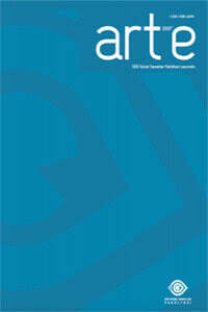Güncel Sanatta Estetik Deneyim ve Oyun
Güncel Sanat, Çağdaş Sanat, Oyun, Estetik Deneyim.
THE PLAY AND AESTHETIC EXPERIENCE IN CONTEMPORARY ART
Contemporary Art, Contemporary Aesthetics, Play, Aesthetic Experience.,
___
- Bishop, C. (2018). Yapay Cehennemler: Katılımcı Sanat ve İzleyici Politikası. Çev. M. Haydaroğlu. İstanbul: Koç Üniversitesi Yayınları.
- Bourriaud, N. (2005). İlişkisel Estetik, çev. Saadet Özen, İstanbul: Bağlam Yayınları.
- Gadamer, H. G. (2005). Güzelin Güncelliği, çev. F. Tepebaşlı, Konya: Çizgi Yayınları.
- Gadamer, H. G. (2008). Hakikat ve Yöntem, cilt 1. (Çev. H. Arslan ve İ. Yavuzcan). İstanbul: Paradigma
- Hagman, G. (2011), Aesthetic Experience, Beauty, Creativity, and the Search for the Ideal, Amsterdam: Nedherland. Press: Rodopi.
- Hein, H. (1968). Play as an Aesthetic Concept, The Journal of Aesthetics and Art Criticism, Vol. 27, No. 1 (Autumn, 1968), pp. 67-71 Published by: Wiley
- Huizinga, J. (2015). Homo Ludens: Oyunun Toplumsal İşlevi Üzerine Bir Deneme. İstanbul: Ayrıntı Yayınları.
- Jones, A. (1994). Postmodernism and the En-gendering of Marcel Duchamp. Cambridge University Press: Cambridge,
- Homeros, (1971) İliada, İlias Destanı, Çev. Emre, A. C., İstanbul: Varlık Yayınları.
- Kant, I. (2011). Yargı Yetisinin Eleştirisi, Çev, Aziz Yardımlı, Ankara: İdea Yayınları.
- Kelley J. (2004), Childsplay : Allan Kaprow'un sanatı, Berkeley, Londra: University of California Press,
- Markovic, S. (2012). “Components Of Aesthetic Experience: Aesthetic Fascination, Aesthetic Appraisal, And Aesthetic Emotion”, i-Perception (2012) volume 3, p. 1 –17
- Morgan, J. (2003). Common Wealth, Londra: Tate Publishing.
- Platon, (t.y). Devlet, Çeviren: C. Saraçoğlu – V. Atayman, İstanbul: BS yayın dağıtım.
- Rosenthal, M. (2003), Understanding Installation Art: From Duchamp to Holzer, Munich: Prestel. Schechner, R. (1994) Environmental Theater. New York: Applause Theatre & Cinema Books
- Schiller, F. (2020). İnsanın Estetik Eğitimi Üzerine, çev. Gürsel Aytaç. Ankara: Fol Kitap.
- Soykan, Ö. N. (1991). “Sanatın Kaynağı Sorunu Oyun ve Dans”. Felsefe Dünyası Dergisi, 2, 39-54
- Tunalı, İ. (1998). Estetik, İstanbul: Remzi Kitapevi,
- Tunalı, İ. (2011), Grek Estetiği, İstanbul, Remzi Kitabevi.
- Yayın Aralığı: 2
- Başlangıç: 2008
- Yayıncı: Süleyman Demirel Üniversitesi Güzel Sanatlar Fakültesi
21. Yüzyılda Güncel Lif Sanatı ve Enstalasyon Örnekleri
Kübra Nur YALDIZBAŞ, Kafiye Özlem ALP
Çirkin ve Hizmetçiler Oyunlarında Biyoiktidar Kavramı
Azerbaycan’da Hanlıklar Dönemi Erkek Milli Kıyafetleri ve Günümüz Giysi Tasarımına Bir Uyarlama
Kültürel Kimliğin Sürdürülebilmesinde Bir Araç Olarak Grafik Elemanlar
Kıymet SANCAR ÖZYAVUZ, Kübra AKTEPE ÖZBAYRAK, Reyhan MİDİLLİ SARI
Ebru Sanatının Havlu ve Peştamal Yüzeyine Uygulanabilirliğinin İncelenmesi
Pelin AYKAR, Reyhan POLAT, Duygu İrem CAN
Slow Food ve Slow Fashion: Sürdürülebilir Yaşamın Yeni Trendleri
Fréderic François Chopin’in Op. 6 No.1 Mazurka Eserinin Form Analizi
Mustafa EREN, Ajda ŞENOL SAKİN
Sanat ve Sinizm (Yabancılaşma) İlişkisi: George Grosz ve Andy Warhol
Burcu Nur CENGİZ, Zeliha AKÇAOĞLU
Johannes Palaschko’nun Op. 49 10 Etüdüne Yönelik Çalışma Önerileri
